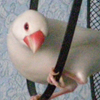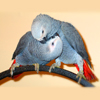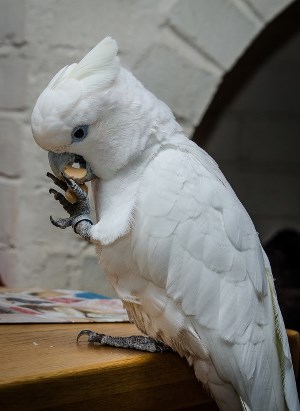Loriai ir loriketės - Loriinae pošeimis
34 pranešimai(ų)
• Puslapis 3 iš 4 • 1, 2, 3, 4
Dar viena nuoroda lysenkizmo propaguotojams kurie neskiria loriu ir loriketu (is wikipedia)
Lories and lorikeets are small to medium-sized arboreal parrots which comprise the subfamily Loriinae. They have specialized brush-tipped tongues for feeding on nectar and soft fruits, and the majority have very brightly colored plumage. Lories are widely distributed throughout the Australasian region, including south-eastern Asia, Polynesia, Papua New Guinea and Australia.
Contents [hide]
1 Classification
1.1 Nomenclature
2 Characteristics
3 Conservation
3.1 Subfamily Loriinae
3.2 External links
[edit] Classification
Lories are usually classified as Loriinae, the most clearly distinct of the several rather uncertain subfamilies within the Psittacidae. Some authorities regard the differences between the Loriinae and the other parrots as sufficient to justify promoting the group to full family status, in which case, following the biological naming conventions, they become the Loriidae, and are placed alongside the remaining true parrots (Psittacidae) and the cockatoos (Cacatuidae) within the biological order Psittaciformes.
[edit] Nomenclature
Zemiau labai aiskiai parasyta kodel vienais atvejais naudojama angliskas zodis lory kitu lorikeet!!!!!!!!!!!!!!!
Much like "parrot" and "parakeet" the usage of the terms "lory" and "lorikeet" is highly subjective. Species with longer, tapering tails are generally referred to as "lorikeets" while species with short, blunt tails are referred to as "lories". [1]
The Rainbow Lorikeet was one of the species of parrots appearing in the first edition of The Parrots of the World and also in John Gould's lithographs of the Birds of Australia. At that time and since they have been popularly described as one of the most beautiful species of parrot.
[edit] Characteristics
Tongue of a LoryLorikeets eat nectar from about 5,000 species of flowers. To collect the nectar they use their specialised tongues. On the tip of their tongues they have many protrusions; a tuft of papillae (extremely fine hairs). They extend to effectively collect nectar and pollen. Lorikeets have tapered wings and pointed tails that allow them to fly easily and display great agility.[citation needed] They also have strong feet and legs. They tend to be hyperactive and clownish in personality both in captivity and the wild.
Lories and lorikeets are small to medium-sized arboreal parrots which comprise the subfamily Loriinae. They have specialized brush-tipped tongues for feeding on nectar and soft fruits, and the majority have very brightly colored plumage. Lories are widely distributed throughout the Australasian region, including south-eastern Asia, Polynesia, Papua New Guinea and Australia.
Contents [hide]
1 Classification
1.1 Nomenclature
2 Characteristics
3 Conservation
3.1 Subfamily Loriinae
3.2 External links
[edit] Classification
Lories are usually classified as Loriinae, the most clearly distinct of the several rather uncertain subfamilies within the Psittacidae. Some authorities regard the differences between the Loriinae and the other parrots as sufficient to justify promoting the group to full family status, in which case, following the biological naming conventions, they become the Loriidae, and are placed alongside the remaining true parrots (Psittacidae) and the cockatoos (Cacatuidae) within the biological order Psittaciformes.
[edit] Nomenclature
Zemiau labai aiskiai parasyta kodel vienais atvejais naudojama angliskas zodis lory kitu lorikeet!!!!!!!!!!!!!!!
Much like "parrot" and "parakeet" the usage of the terms "lory" and "lorikeet" is highly subjective. Species with longer, tapering tails are generally referred to as "lorikeets" while species with short, blunt tails are referred to as "lories". [1]
The Rainbow Lorikeet was one of the species of parrots appearing in the first edition of The Parrots of the World and also in John Gould's lithographs of the Birds of Australia. At that time and since they have been popularly described as one of the most beautiful species of parrot.
[edit] Characteristics
Tongue of a LoryLorikeets eat nectar from about 5,000 species of flowers. To collect the nectar they use their specialised tongues. On the tip of their tongues they have many protrusions; a tuft of papillae (extremely fine hairs). They extend to effectively collect nectar and pollen. Lorikeets have tapered wings and pointed tails that allow them to fly easily and display great agility.[citation needed] They also have strong feet and legs. They tend to be hyperactive and clownish in personality both in captivity and the wild.
- Donatas
- Pranešimai: 75
- Užsiregistravo: 2007.03.16 11:23
Jei neklystu, nes pavadinimo užrašyta nebuvo, tai šiandien Vilniuje, Big-e, mačiau šitą grožį(kaina 1150 lt.). Stovėjau ir negalėjau atsitraukti - graži papūga nerealiai 

-

linosa - Pranešimai: 47
- Užsiregistravo: 2010.03.16 15:27
- Miestas: Vilnius
- Augintiniai:
tai greiciausia is Kauno akropolyje esancios Pet center parduotuves perveztas loriukas, cia jie buvo tryse. kai kalbejau su pardavejom sake kad viena perveze i sostine
-

deivis373 - Pranešimai: 332
- Užsiregistravo: 2009.05.01 14:27
- Miestas: Kaunas
ai koks sutapimas, aš irgi šiandien bige buvau, gerėjausi  gražuolė papūga. Tokia "kislotna" nu jau tokia ryški:))
gražuolė papūga. Tokia "kislotna" nu jau tokia ryški:))
 gražuolė papūga. Tokia "kislotna" nu jau tokia ryški:))
gražuolė papūga. Tokia "kislotna" nu jau tokia ryški:))-

Madeira - Pranešimai: 268
- Užsiregistravo: 2010.10.02 15:43
- Miestas: Vilnius
- Augintiniai:
Spalvos šių papūgų tai tikrai laabai gražios, ryškios ryškios... neina atsižiūrėti. Akropolyje tai jos atrodo porą sudariusios, gražiai tarpusavyje bendrauja.
Tiesa tokios nuogirdos, kad jos tuštinasi nelabai kaip... Na pro narvo grotas pvz tiesiai ant sienų įdomu tai tiesa ar tik spėlionės...
įdomu tai tiesa ar tik spėlionės...
Tiesa tokios nuogirdos, kad jos tuštinasi nelabai kaip... Na pro narvo grotas pvz tiesiai ant sienų
 įdomu tai tiesa ar tik spėlionės...
įdomu tai tiesa ar tik spėlionės...-

gitutee - Pranešimai: 479
- Užsiregistravo: 2008.08.26 17:06
- Miestas: Kaunas
- Augintiniai:
Kadangi minta daugiausiai skystu maistu tai ir išmatos skystos būna  Dabar kikose mačiau 25 % akcija joms
Dabar kikose mačiau 25 % akcija joms 
 Dabar kikose mačiau 25 % akcija joms
Dabar kikose mačiau 25 % akcija joms 
-

viliuss - Pranešimai: 2652
- Užsiregistravo: 2009.06.27 20:22
- Miestas: Šeduva
- Augintiniai:
Na nežinau, bet kai mačiau parodoje, tai nieko ten baisaus tos išmatos - vandenukas ir ant žmonių kiaurai grotas nevarė  Bet nepaauginęs tiksliai nežinosi. Na turėtų gi atsirasti augintojas
Bet nepaauginęs tiksliai nežinosi. Na turėtų gi atsirasti augintojas 
 Bet nepaauginęs tiksliai nežinosi. Na turėtų gi atsirasti augintojas
Bet nepaauginęs tiksliai nežinosi. Na turėtų gi atsirasti augintojas 
-

Papooga - Pranešimai: 10520
- Užsiregistravo: 2007.01.23 00:17
- Miestas: Vilnius
- Augintiniai:
Manau auginti jų nieks neskuba dėl jų specifinės mitybos. Nors Panevėžy ZooPlanet maitina sausiaku, sakė jokių pastų ir tyrelių neduoda ir gyvena paukštukai, nors savaime aišku tokia mityba jiems ne į naudą. Bet jau net kika tom tyrėm prekiauja. Tad problemos kaip ir nebėr.Tik tos tyrės kaina pažiūrėjau 50 lt už dėžutę - kaži kiek jos užtenka 

-

viliuss - Pranešimai: 2652
- Užsiregistravo: 2009.06.27 20:22
- Miestas: Šeduva
- Augintiniai:
34 pranešimai(ų)
• Puslapis 3 iš 4 • 1, 2, 3, 4
Dabar prisijungę
Vartotojai naršantys šį forumą: Registruotų vartotojų nėra ir 9 svečių




